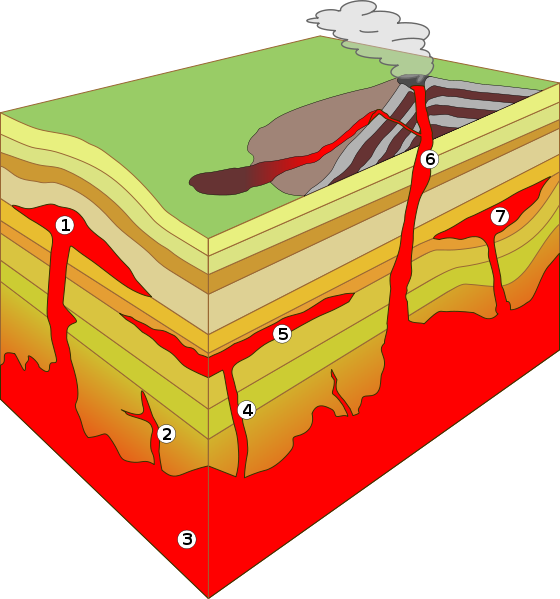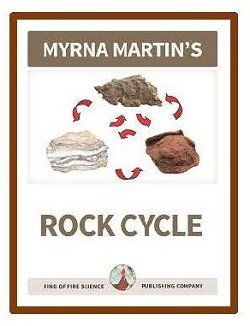What are Intrusive Rocks?
intrusive rocks were once molten rock
Molten rock crystallizes underground
Intrusive rocks form beneath the Earth's surface when molten rock crystallizes inside the Earth. Batholiths are the largest intrusive rock structures. They cover hundreds of square kilometers when they are exposed by erosion.
Intrusive rocks in subduction zones
Intrusive rocks are often found in subduction zones. These intrusive rock structures form deep underground. They can only be seen when they are exposed by erosion. Batholiths have formed mountain ranges when the overlying layers have eroded away. Other intrusive rocks can be observed in road cuts and along river banks.

Common intrusive rock structures: #1 Laccolith, #2 & #4 Dikes, #3 Batholith, #4 Sill, #6 Volcanic neck or pipe, and #7 Lopolith
Batholiths
Batholiths are the largest intrusive bodies
Batholiths are the largest intrusive bodies in the crust of the Earth.
These large bodies of intrusive rocks can cover thousands of square kilometers of
land. They form intrusions that are longer than they are thick. Sometimes batholiths form elliptical or
circular shapes.
Batholiths form deep underground
Batholiths form deep underground within the crust of the Earth. Batholiths are only exposed in places where extensive erosion has
occurred.
They often occur in subduction zones and mountain ranges. Many batholiths contain several plutons that are solidified magma chambers.
Typical rocks found in batholiths
Typical rocks found in batholiths are granite, gabbro and
diorite. The coarse-grained rocks cooled slowly deep underground.
Sierra Nevada Mountains
The Sierra Nevada Mountains are an examples of a large exposed batholith in California. El Capitan and Half Dome in Yosemite National Park are part of the Sierra Nevada Batholith.


Click for More Information and to Order
Laccoliths & Lopoliths
Laccoliths form mushroom shaped intrusions
A laccolith is a mushroom shaped intrusion of molten rock. It
forms a flat floor and a rounded roof. The rounded roof formed when the molten
rock pushed the overlying sediments into the shape of a dome.
The bottom of the laccolith is presumed to be flat. Molten rock flowed between the rock layers as the laccolith increased in size. Usually a dike was the conduit between the magma chamber and the laccolith as it increased in size.
Diameter and thickness of laccoliths
Laccoliths are roughly circular intrusive bodies that are
less than 16 km in diameter. They range in thickness from a few hundred meters
to thousands of meters thick.
Lopoliths are horizontal intrusions
A lopolith is generally a horizontal intrusion similar to a table. It is generally about ten to twenty times wider than it is thick.
Lopoliths form convex shapes
A large lopolith typically has layered igneous rock intrusions that form a convex shape. The central part of a large lopolith has a sunken bowl like shape . The weight of the molten rock intruding the area causes the underlying country rock layers to sag downward forming the its convex shape in the center.
Sills and Dikes
Sills are horizontal intrusions
A sill is a flat table like structure that magma intrudes
between layers of older rocks. Sills are similar in size to dikes. They sometimes form at the same time. Sills may also form columnar structures as the molten
rock cools.
Palisades is a sill along the Hudson River
A famous example of columnar structures in the Palisades
sill is exposed along the Hudson River in New Jersey. The basaltic structure is
3000 meters thick and is about 65 km long.
Dikes are vertical intrusions
Dikes are a sheetlike body that cuts across the layers of country
rocks in a roughly vertical or near vertical direction. The length and width of dikes are much larger than their thickness.
Magma fills in fractures of older rocks
Molten rock (magma) is squeezed into vertical
or near vertical fractures in the rocks. The fractures can be less than a few
centimeters thick to hundreds of meters thick. Dikes have been found to extend for many
kilometers.
Dikes are visible in road cuts
The molten rock moves upward toward the Earth's surface forming dikes in cracks and fractures of the surrounding country rocks.
The rocks that form in these cracks are often visible in road cuts. They are vertical layers of rock that is a different color than the country rock that surrounds the dike.
Volcanic necks or pipes
Volcanic pipes connect magma chambers to vents
Volcanic necks or pipes connect a magma chamber to the vent
of a volcano. Dikes often occur in groups that radiate from volcanic necks that formed during volcanic eruptions on the sides of stratovolcanoes when the neck of the volcano was plugged.
Pipes form a volcanic plug that stands alone when the softer sediments around the volcanic neck erode away.
Volcanic necks seal the vent and conduits
Volcanic necks are tower like masses of rock that seal the
vent of the volcano and conduits of dormant or recently dormant volcanoes. The
rocks are both fine-grained and coarse-grained. The intrusive rocks in the
volcanic neck are often porphyries containing large and small crystals.
KIDS FUN Science Bookstore
Check out Myrna Martin's award winning textbooks, e-books, videos and rock sets. The Kids Fun Science Bookstore covers a wide range of earth science topics. Click here to browse.










